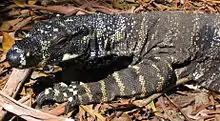Varanoidea
Varanoidea is a superfamily of lizards, including the well-known family Varanidae (the monitors or goanna). Also included in the Varanoidea are the Lanthanotidae (earless monitor lizards), and the extinct Palaeovaranidae.
| Varanoidea | |
|---|---|
 | |
| Lace monitor (Varanus varius) | |
| Scientific classification | |
| Kingdom: | Animalia |
| Phylum: | Chordata |
| Class: | Reptilia |
| Order: | Squamata |
| Suborder: | Anguimorpha |
| Infraorder: | Paleoanguimorpha |
| Superfamily: | Varanoidea Münster, 1834 |
| Families | |
| |
Throughout their long evolutionary history, varanoids have exhibited great diversity, both in habitat and form. This superfamily includes the largest-known terrestrial lizard, Megalania (5–6 meters), and the largest extant lizard, the Komodo dragon (Varanus komodoensis, 3+ meters).
Evolution

Either synonymous with, or a subgroup of, the group Platynota, the varanoids first appear in the fossil record in the latter part of Early Cretaceous, but possible varanoid ancestors have been traced back as far as Early Jurassic times. Among the earliest known varanoids are the monitor-like necrosaurids Palaeosaniwa canadensis from the Campanian (roughly 71-82 mya) of North America and Estesia mongoliensis and Telmasaurus grangeri, both from the Campanian of Mongolia. Varanoids survived the Cretaceous–Paleogene extinction event and flourished worldwide during the Cenozoic Era. Current evidence strongly suggests that snakes evolved from an aquatic or burrowing varanoid ancestor, though much debate continues over precisely which lineage of varanoids.
Carroll characterises the varanoids as "the most advanced of all lizards in achieving large size and an active, predaceous way of life". Some taxa, such as the extinct necrosaurids and the possibly varanoid Gila monsters, were armoured with osteoderms (bony deposits on the skin), and many forms have hinged jaws, allowing them to open their mouths very wide when feeding (though they cannot dislocate their jaws, contrary to popular belief).[1][2]
References
- Carroll, R. L. 1988. Vertebrate Paleontology and Evolution. W. H. Freeman and Co. NY. p. 232
- Molnar, R. E. 2004. Dragons in the Dust: The Paleobiology of the Giant Monitor Lizard Megalania. Indiana University Press (Bloomington/Indianapolis)